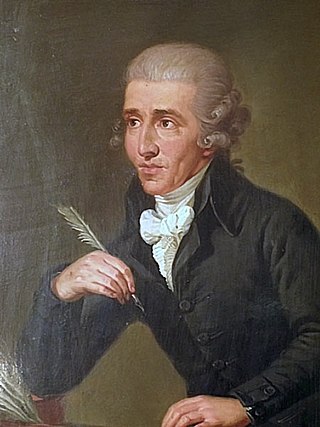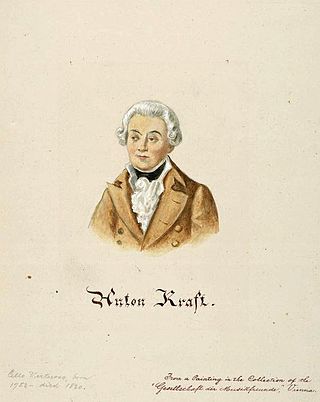Related Research Articles

A violin concerto is a concerto for solo violin and instrumental ensemble. Such works have been written since the Baroque period, when the solo concerto form was first developed, up through the present day. Many major composers have contributed to the violin concerto repertoire, with the best known works including those by Bach, Bartók, Beethoven, Brahms, Bruch, Dvořák, Khachaturian, Mendelssohn, Mozart, Paganini, Prokofiev, Sarasate, Shostakovich, Sibelius, Tchaikovsky, and Vivaldi.

Trevor David Pinnock is a British harpsichordist and conductor.
D major is a major scale based on D, consisting of the pitches D, E, F♯, G, A, B, and C♯. Its key signature has two sharps. Its relative minor is B minor and its parallel minor is D minor.
E-flat major is a major scale based on E♭, consisting of the pitches E♭, F, G, A♭, B♭, C, and D. Its key signature has three flats. Its relative minor is C minor, and its parallel minor is E♭ minor,.

The Cello Concerto No. 1 in C major, Hob. VIIb/1, by Joseph Haydn was composed around 1761-65 for longtime friend Joseph Franz Weigl, then the principal cellist of Prince Nicolaus's Esterházy Orchestra.

Joseph Haydn composed the Concerto per il Clarino in 1796 for the trumpet virtuoso Anton Weidinger. Joseph Haydn was 64 years of age. A favourite of the trumpet repertoire, it has been cited as "possibly Haydn's most popular concerto". Although written in 1796, Weidinger first performed the concerto four years later on March 28, 1800.

Antonín Kraft was a Czech cellist and composer. He was a close friend of Haydn, Mozart, and Beethoven.
The Hoboken catalogue is a catalogue of the musical compositions by Joseph Haydn compiled by Anthony van Hoboken. It is intended to cover the composer's entire oeuvre and includes over 750 entries. Its full title in the original German is Joseph Haydn, Thematisch-bibliographisches Werkverzeichnis. The Haydn catalogue that now bears Hoboken's name was begun in card format in 1934; work continued until the publication of the third and final book volume in 1978.
The Violin Concerto No. 1 in C major by Joseph Haydn, fatto per il luigi, was written in the 1760s for a well-known violinist of the time, Luigi Tomasini, who was just back from Italy and soon became the concertmaster of the Esterházy orchestra.

Joseph Haydn's Symphony No. 31 in D major, Hob. I/31, was composed in 1765 for Haydn's patron Nikolaus Esterházy. It is nicknamed the "Hornsignal Symphony", because it gives a prominent role to an unusually large horn section of four players. Probably because of its prominent obbligato writing for the horns, in Paris, the publisher Sieber published this symphony as a "symphonie concertante" around 1785.

The Violin Concerto No. 4 in G major by Joseph Haydn is one of the composer's three surviving violin concertos.
The Sinfonia Concertante in B flat major, by Joseph Haydn was composed in London between February and March 1792. The work is a sinfonia concertante with four instruments in the solo group: violin, cello, oboe and bassoon. It is believed to be a response to similar works composed by Ignaz Pleyel, a former student of Haydn's who London newspapers were promoting as a 'rival' to Haydn. In addition to the solo group the Sinfonia Concertante is scored for flute, 2 oboes, 2 bassoons, 2 horns, 2 trumpets, timpani and strings.

The Missa brevis Sancti Joannis de Deo, Hob. XXII:7, Novello 8, is a mass in B-flat major by Joseph Haydn. The missa brevis was written around 1774 for the order of the Barmherzige Brüder in Eisenstadt, whose patron saint was John of God. Scored modestly for soprano, four-part mixed choir, two violins, organ and bass, it is known as the Kleine Orgelmesse due to an extended organ solo in the Benedictus movement.
References
- Notes
- ↑ "Violin Concerto in A major ("Melker Konzert"), H. 7a/3". allmusic.com. Retrieved 8 January 2009.
- ↑ "Joseph Haydn, Concerto in A major, Violin and orchestra". EditionHH Music publishers. Retrieved 8 January 2009.
- Sources
- Thomas, Günter. Preface (PDF). Concerto for Violin and Orchestra A major Hob. VIIa:3. By Haydn, Joseph. Lohmann, Heinz (ed.). (in German, English, and French). G. Henle Verlag. Archived from the original (PDF) on 2011-07-18.